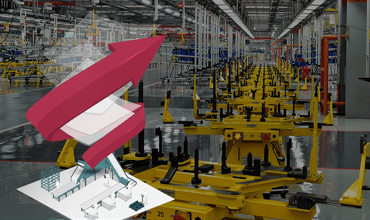Paperless Factory Value Summary
Work instructions displayed electronically allow precise control and assurance of operations which can change flexibly, without the burden of managing physical paper-based instructions that can be misplaced, difficult to change, setup and manage. Paperless documentation brings greater flexibility in manufacturing whilst also reducing the risk of mistakes. The creation time and effort to create paperless manufacturing documentation is also greatly reduced using electronic tools, with very little need for manual data manipulation. With the addition of FactoryOptix Augmented Reality (AR), which requires no further effort for data preparation, hands-free, untethered manufacturing becomes a reality, increasing productivity as well as creating further flexibility for operators on the shop-floor as they can be directed seamlessly between work assignments across assembly, logistics etc.
What Is The Paperless Factory?
Paper-Based Work Instructions
The use of paper as the mechanism to convey manufacturing work instructions has been with us since the start of mass production, where each operator is assigned specific tasks to perform. There are significant challenges when working with paper-based work instructions. Creating paper-based work instructions requires many hours of engineering lead-time, creating the perfect work assignment between production operators, creating drawings and step-by-step instructions, and then making sure that the correct documents are set up and displayed in the right place at the right time. For high-volume manufacturing this workload was once acceptable, but for high mix or low volume manufacturing where there are frequent changes, the workload for paper-based document creation, revision, and management quickly becomes unsustainable.
Early Electronic Work Instructions
Many examples of electronic work instructions today use an electronic display that simply mimics what would have been printed on paper, such as showing a PDF file. Operators are not able to interact with the display, nor could they query information about the contents within the visuals, limiting the value and return on investment when considering the cost of the hardware, the energy consumed and the space needed.
Fully Interactive Work Instructions
With Aegis as the long-term market leader in interactive work instructions, the technology within FactoryLogix today allows for a completely paperless factory operation, based on fully interactive work instructions and other documentation, delivered either through operator PC’s, mobile devices, or Augmented Reality (AR) glasses.
Dynamic data content is used to create digital work instructions, featuring the ability to focus in on key areas as required, providing reference material and additional detail, with product and operational imagery, for example, animations and short, repeating video clips The display for the operator is generated dynamically, in real-time, according to the specific tasks being performed. This eliminates operator learning curves, improving productivity and quality.
FactoryLogix interacts with the operator, who can now perform complex step-by-step operations and confirmations, without specialist knowledge or training. All the tools are provided to take media and information from many sources, including the original product design, and insert them quickly and efficiently into a set of dynamic and interactive work instructions, the “operator cockpit”. Operators are able to confirm that each step has been completed, to record data for use with traceability, to provide feedback to help improve the process, and much more. The technology promotes the ability for any operator to perform any assembly task, on any product, at any time.
FactoryOptix – Augmented Reality
The same fully interactive digital work instruction information seen on interactive monitors, can also be superimposed on top of the natural view of the operator through the use of AR glasses. There is no longer any need for the operator to look away from the job they are performing to look at an instruction. Nor is there a need to have a PC or even mobile device accompanying assembly operators for them to receive detailed visual work guidance. Execution tasks performed by the operator are also enhanced, for example, the process of reading unique product or material IDs using the integrated camera, triggered by a voice command.
FactoryLogix & The Paperless Factory
The best practice for any new product introduction and setup is for there to be as little human-based data manipulation as possible. Creating paperless documentation through the use of templates and original electronic design information, based on the FactoryLogix internal digital model of a product instance, allows instructions to be created quickly and with greatly reduced risk of mistake.
Taking the data preparation time down from several days to just a few minutes is an essential step for any manufacturing operation that requires flexibility. The unique way in which FactoryLogix allows product manufacturing instances to be assigned to any production configuration, with any variant, and with a dynamic choice of approved materials, together with paperless work instructions, brings industry leading flexibility to every corner of the manufacturing operation, including complex electronics assemblies, very large mechanical assembly, critical product assembly, and the material supply-chain associated with each.
As well as saving the environment, reducing engineering time and effort as well as reducing mistakes, FactoryLogix paperless factory uniquely provides the flexibility required for true Industry 4.0 operations.








